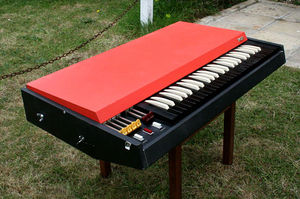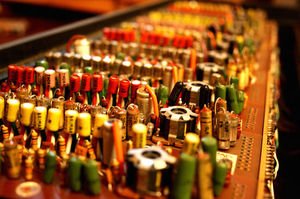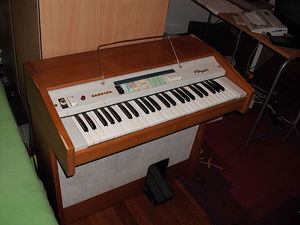The Vox and Farfisa: Difference between revisions
m (Text replace - "[[Category:Computers and information processing" to "[[Category:Computing and electronics") |
m (Text replace - "[[Category:Culture and society" to "[[Category:Engineering and society") |
||
| Line 15: | Line 15: | ||
In the early 1970s, the appeal of that sound wore off, and musicians turned to more elaborate instruments, including the [[Hammond B3 Organ|Hammond organ]] and the new breed of more sophisticated “synthesizers,” such as the [[Moog|Moog]]. Many combo organs languished in closets and basements for years after that, before being resurrected in the 1980s and 1990s to create the “retro” sound of groups like Stereolab, the Fleshtones, and the Soup Dragons. | In the early 1970s, the appeal of that sound wore off, and musicians turned to more elaborate instruments, including the [[Hammond B3 Organ|Hammond organ]] and the new breed of more sophisticated “synthesizers,” such as the [[Moog|Moog]]. Many combo organs languished in closets and basements for years after that, before being resurrected in the 1980s and 1990s to create the “retro” sound of groups like Stereolab, the Fleshtones, and the Soup Dragons. | ||
[[Category:Business, management & industry|Vox]] [[Category:Computing and electronics|Vox]] [[Category:Business|Vox]] [[Category: | [[Category:Business, management & industry|Vox]] [[Category:Computing and electronics|Vox]] [[Category:Business|Vox]] [[Category:Engineering and society|Vox]] [[Category:Leisure|Vox]] [[Category:Music|Vox]] [[Category:Solid state circuits|Vox]] [[Category:Transistors|Vox]] [[Category:News|Vox]] | ||
Revision as of 16:45, 22 July 2014
The Vox and Farfisa
Keyboard instruments were a problem for the pioneers of rock and roll music. Numerous rock performers and “combos” (bands) of the 1950s used pianos in the studio, but it was difficult to amplify a piano properly so that it could be heard in live performances over electric guitars and drums. Electronic keyboard instruments like the mighty Hammond B3 were available, but were expensive and difficult to lug around. All that changed with the invention of the transistor. Smaller, cheaper, and less power-hungry than the electron tubes that weighed down big electronic organs, transistors made it possible for instrument manufacturers to reduce the size and cost of keyboard equipment. Two of the resulting instruments were the Vox and Farfisa.
The first transistorized organs were built for home entertainment, and although rockers sometimes brought them on stage, they were not really made to withstand the inevitable rough handling of life on the road. Worse, they didn’t look very cool—nowhere near as cool as an electric guitar or a drum kit. Then, in 1960, came the Vox Continental. Made in England (and elsewhere later), the Vox was relatively affordable, sleek, rugged, and could be partially disassembled and packed in its special case for transport. Musicians from the Beatles to the Animals snapped them up.
As psychedelic rock hit in the later 1960s, another important transistor organ brand became available, this time from Italy. The Farfisa organ, introduced in 1965, was even less expensive and more compact—in fact, the top-selling Farfisa of the late ‘60s was called the Combo Compact. By the end of the decade there were dozens of different brands of “combo” organs on the market, many featuring attractively styled, brightly colored plastic cases. The distinctive sound of these combo organs was probably intended to emulate a conventional pipe organ, although the similarity was quite vague. Yet the tinny, shrill output of these combo organs gave rise to a distinctive and instantly identifiable “60s sound” that was shared by some of the most popular groups of the day. For an idea of what the 60s sound was like, listen to such songs as The Animals’ “House of the Rising Sun,” or Iron Butterfly’s “In-a-gadda-da-vida.”
In the early 1970s, the appeal of that sound wore off, and musicians turned to more elaborate instruments, including the Hammond organ and the new breed of more sophisticated “synthesizers,” such as the Moog. Many combo organs languished in closets and basements for years after that, before being resurrected in the 1980s and 1990s to create the “retro” sound of groups like Stereolab, the Fleshtones, and the Soup Dragons.


